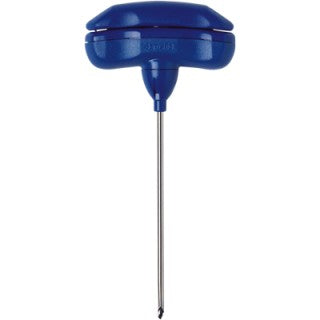Description
Carefusion TJC4088 - TJ JAMSHIDI BONE MARROW NEEDLE 8GA x 4 10EA/CA

T-Handle Jamshidi Bone Marrow Biopsy Aspiration Needle
The T-handle Jamshidi bone marrow aspiration and biopsy needle helps ensure comfort and excellent cortical penetration. It is available with or without the marrow acquisition cradle, allowing you to tailor the needle to your patient''s unique needs.
Comfortable feel
The ergonomic T-handle fits comfortably in your hand, providing tactile feedback and increased control.
Advanced design
The trocar-tip stylet and triple crown-tip cannula provide a sharp cutting edge requiring 25% less force than before.
Marrow acquisition cradle
This device helps capture quality samples and allows multiple sampling to eliminate painful redirection.
 |
 |
Features & Benefits
Procedural efficiency
The two-piece, easy-to-use design provides tactile feedback and helps increase control during needle insertion.
Single-use design
This design helps assure sterility for every procedure and prevent cross-contamination.
Comfortable handle
The two-piece T-handle design is procedurally efficient, simple to use and fits comfortably in your hand. The two-piece T-handle is also designed to provide tactile feedback and increased control during needle insertion.
Superior Cortical Penetration
The T-handle Jamshidi bone marrow biopsy needle features a trocar-tapered stylet point and a triple-crown cannula tip. These features provide a sharp, effective cutting edge for superior cortical penetration and medullary advancement that requires 25% less physical force. Available with or without the marrow acquisition cradle, the T-handle Jamshidi needle allows clinicians to tailor the device to individual patient needs.
T-Handle Jamshidi Bone Marrow Biopsy/Aspiration Needle with Marrow Acquisition Cradle

Note: Use these instructions only as a reference. Read the Directions for use that accompany the product for more detailed instructions.
- Introduce the needle through the incision, and using firm pressure, slowly advance the needle while rotating the needle 45 in an alternating clockwise/counter-clockwise motion. (A and B) Entrance into the marrow cavity is generally detected by decreased resistance.
- Rotate the stylet 90 counter-clockwise, and pull the stylet out of the handle.
With the stylet removed, slowly advance the needle with a slight clockwise/counter-clockwise motion until adequate marrow is obtained.
Note: Sample architecture may be damaged with excessive clockwise/counter-clockwise movement.Insert the combined support rod and specimen cradle into the needle. (C) Advance only far enough to rest on top of the specimen. Approximation of specimen length can be identified at this time.
Advance the specimen cradle down to the handle base while maintaining the support rod in a stationary position. (D)

A. Remove the specimen cradle and support rod from the needle. Assess the adequacy of the trephine; or
B. Slowly remove the needle, specimen cradle and support rod from the patient with a gentle clockwise/counter-clockwise motion. Remove the specimen cradle and support rod from the needle.A. Advance the support rod through the specimen cradle to remove the biopsy specimen; (F) or
B. Place the probe guide onto the distal cannula tip. Insert the probe into the guide, and remove the biopsy specimen. (G)
Frequently Asked Questions
Q: What is bone marrow?
A: Spongy material in the center of most large bones. Bone marrow contains different cells that make up blood and produces red blood cells, white blood cells and platelets.
Q: What is a bone marrow biopsy?
A: A procedure that removes a sample of bone marrow from the inside of bone for examination.
Q: How is a bone marrow biopsy performed?
A: Physician will clean your skin and inject a numbing medicine on the surface of where the bone marrow will be taken. He or she will then insert a biopsy needle through the bone, into the bone marrow to capture a bone marrow sample. After removing the sample and needle, he or she will apply pressure and a bandage to stop any bleeding.
Q: How do I prepare for a bone marrow biopsy?
A: Tell your physician if you are allergic to any medications, on any medications, prone to bleeding and/or pregnant. You will also need to sign a consent form.
Q: How will the bone marrow biopsy feel?
A: The injection of the numbing medicine may cause a sharp sting, and the biopsy needle may briefly cause pain, but it is usually dull. The biopsy may cause discomfort considering the inside of bone cannot be numbed.
Q: Why is a bone marrow biopsy performed?
A: A physician may want to test your abnormal red or white blood cell or platelet types or counts, or test you for leukemia, infections, anemia and other blood disorders. It can also be used to determine if a cancer has spread or responded to treatment.
Q: What is a normal result of a bone marrow biopsy?
A: The bone marrow contains the proper number and types of blood-forming cells, fat cells and connective tissues.
Q: What are abnormal results of a bone marrow biopsy?
A: The bone marrow may indicate leukemia, lymphoma, multiple myeloma or other cancers. It may also show a low red blood cell count, which can cause anemia; abnormal white blood cells; or a low platelet count.
Q: What are the risks of a bone marrow biopsy?
A: Some bleeding at the puncture site. More serious bleeding or infection can occur, but it is rare.
